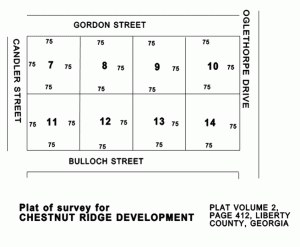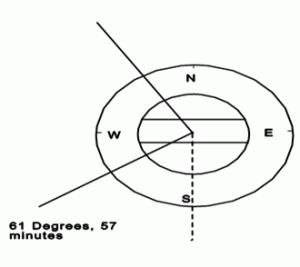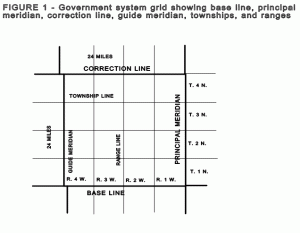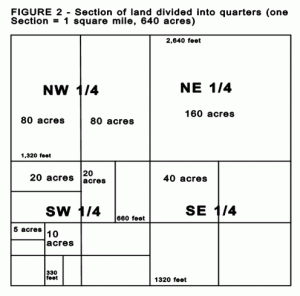Chapter 27
Legal Descriptions Used in Georgia
INTRODUCTION
The legal description of a property is the method of identifying the boundaries for that property as clearly and completely as possible. It is also allows the owner to know where his or her property is in relationship to all other properties, especially the adjacent properties. Legal descriptions in Georgia use the County, District, and Land Lot, and then use the metes and bounds or the lot and block, also known as the plat map description. Each of these concepts is a topic for discussion in the remaining sections of this chapter.
A proper legal description is an important and necessary item in a real property transaction. A contract for the sale of realty must include a legally sufficient description of the property. The legal description must be specific, must be definite, and must contain sufficient information to enable parties to the contract or others to be able to locate and identify the property. If this description is not complete or if it is vague, the contract would be void or unenforceable.
For example, if the description consists entirely of a notation that the property to be conveyed is “that tract of land known as the grantor’s home place” and contains no more specific information, the contract is not enforceable. The legal description is also a necessary component of a warranty deed, a security deed, and a lease that conveys possession of an entire parcel of property rather than just a rental unit in the property.
THE LEGAL DESCRIPTION SYSTEM IN GEORGIA
In the 1800’s a survey of Georgia divided much of the state into its present grid system of “land lots” and “districts.” In addition, portions of the state use special areas known as “sections,” “headrights,” and “Georgia Militia Districts.” These land area measures are the topics of discussion in the following sections. See Map 1 and Chart 1 for the specific land divisions used in each county.
DISTRICTS AND LAND LOTS
The districts are generally square areas of land and do not necessarily correspond with county boundary lines. Each district consists of smaller square grids of land known as land lots which vary in size from as small as 40 acres in the northern portion of the state to as large as 490 acres in the central and southern portions. The 40 acre land lots were purposely made smaller for the gold lotteries in the 1830’s. Legal descriptions of property located in those areas of the state so divided must include the land lot number and district number. In some areas of the state legal descriptions may use other land divisions in pinpointing the exact location of the property being described.
HEADRIGHTS, GEORGIA MILITIA DISTRICTS (GMDs), AND SECTIONS
(a) HEADRIGHTS – The coastal area of Georgia and some counties in other areas divide property under the “headright” system. Since the laws concerning headrights arose before the survey of the state, there is no grid system of land lots and districts in these areas. Legal descriptions using headrights describe irregularly shaped parcels and are heavily dependent upon natural boundaries such as rivers, streams, and trees.
(b) GEORGIA MILITIA DISTRICTS – Georgia Militia Districts (GMDs) were originally manpower reserve districts organized to provide for the common defense. These land district lines do not conform to county, district, or land lot lines but can isolate a tract of land in drafting legal descriptions, particularly in the Headright area.
(c) SECTIONS – Sections are an additional grid system for land areas that exist in some counties in the northern and northwestern portion of the state. Sections are larger than districts.
THE LOT AND BLOCK OR PLAT MAP SYSTEM

The lot-and-block or plat-map system of legal description for land, sometimes known as the “short form” legal description, uses publicly recorded maps. Most communities require developers or subdividers to have their tracts surveyed and platted into building lots and blocks. This information appears on a map that shows the size and shape of each building lot and its location in the subdivision or land tract. The authorities in each county or jurisdiction evaluate the plat map for compliance with the existing subdivision regulations. The approved plat map appears in the files or records of the local government’s records office. Under this system, the legal description of a parcel of land would contain the following kind of information: the property is Lot #11 in the Chestnut Ridge Development as shown on page 412 of Volume 2 of the Plat Maps for Liberty County.
THE METES AND BOUNDS SYSTEM
The metes-and-bounds system for describing land, sometimes called the long form legal description, uses a fixed point of beginning and then describes a geometric shape using directions, distances, and compass references to describe changes in directions. Monuments or any landmarks that are easily identified can also appear in the metes-and-bounds system. The monuments can be manufactured objects such as fences or markers or natural features such as a distinct rock outcropping, a stream, or even a tree. In more developed areas the intersection of two roads often serves as a monument.
The metes-and-bounds description easily identifies a rectangular piece of property. By use of more sophisticated angular measurements (i.e., degrees, minutes, and seconds), the metes and bounds system can identify any irregularly shaped piece of property. The metes and bounds legal description usually starts with the identification of a monument. Then the description relates the “point of beginning” (the POB) of the property to the monument. From the POB the description continues by specifying the perimeter of the property. An example of a metes and bounds legal description appears below and is taken from the Survey for Robert Smith that appears at the end of this chapter. Note the surveyor’s seal and registration number. Surveying is a licensed profession, and a recordable survey should bear the certificate, seal, and registration number of the surveyor. The legend at the upper left contains information that is useful in drafting the legal description. The surveyor has indicated that the land lies in Land Lot 166 of the 11th District,, 3rd Section of Sparta County, Georgia. The land area (which is not always shown on surveys) is 2.009 acres for this tract of land. Magnetic north points toward the top of the page. We can see that the property boundary lines do not meet the road pavement. This gap is common. The road right-of-way is usually larger than the pavement to allow for future road widening and to place utility lines such as water and sewer.
The property lies at the intersection of Spruell Road and White Oak Road, each of which have 80 foot rights-of-way. The symbol C/L indicates the centerline of the road. The property has iron pins found by the surveyor (I.P.F.) at each corner. The description of the property runs in a clockwise direction. This is standard practice, but not required. Our legal description would begin with a preface paragraph setting out the state, county, land lot, district, section, or militia district where the property is located. Taking the information from the Survey for Robert Smith, our first paragraph would read:
ALL THAT TRACT or parcel of land lying and being in Land Lot 166 of the 11th District, 3rd Section of Sparta County, Georgia, and being more particularly described as follows:
From here, we must determine the point of beginning (P.O.B.) of the courses and distances. The point of beginning is crucial to the legal description; for without it, the legal description can be fatally vague. To establish the point of beginning, a plat of survey must always make reference to a fixed point such as the intersection of two streets. Robert Smith’s property is located at the intersection of two streets, so we can use the rights-of-way as the point of beginning. A word of caution is in order here. The government often widens streets and acquires additional right-of-way. If, for example, the county decided to widen White Oak Road and acquire an additional 10 feet of right-of-way on either side, the fact that the legal description and its point of beginning are based upon the street right of way would not shift all the property boundaries 10 feet to the north. Instead the eastern and western boundaries would become shorter by 10 feet, the southern boundary would shift 10 feet to the north and the northerly boundary would not move. To prevent future problems with the location of boundaries based upon road rights of way, it is customary for a metes and bounds description to state the number of feet in the road right-of-way. The point of beginning of our legal description would be as follows:
Beginning at an iron pin at the intersection of the southwesterly right-of-way of Spruell Road (having a present right-of-way of 80 feet at this point) and the northwesterly right-of-way of White Oak Road (having a present right-of-way of 80 feet at this point);
After establishing the point of beginning, the drafter must then describe the courses and distances of each line so that the boundary closes at the point of beginning. To describe the course of each line, the surveyor uses compass bearings expressed in degrees, minutes, and seconds. There are 90 degrees in each quadrant of the compass (360 degrees total). Each degree can be further divided into 60 parts known as minutes. Each minute contains 60 seconds. The surveyor’s symbol for degrees is a superscripted circle [°]. The symbol for minutes is an apostrophe [‘] and for seconds, quotation marks [“]. The first line of the legal description is expressed in degrees from the point of beginning. The drafter establishes each course by reference to the line last described. For example, the first course relates to the point of beginning. Imagine placing an imaginary protractor on top of the point of beginning with one of the 90 degree bearings facing north:

Each course begins by relating either due north or south to another direction. Since the first line in the survey (proceeding clockwise) is generally south, the surveyor relates the line to due south by measuring the number of degrees (and sometimes minutes and seconds) between due south and the first line. In this survey, the first line is 61 degrees and 57 minutes west of due south, so the course is “south 61 degrees 57 minutes west.” The drafter can then describe the first line (sometimes referred to as a “call”) from the point of beginning, giving the number of feet in the line in addition to the course:
running thence south 61 degrees 57 minutes west along the northwesterly right-of-way of White Oak Road for a distance of 350.0 feet to an iron pin;
The course for the next line is determined as if the drafter placed an imaginary protractor on the point at the end of the first call. The second line is 29 degrees 19 minutes west of due north, as indicated on the plat of survey. The second line would be described:
running thence north 29 degrees 19 minutes west for a distance of 250.0 feet to an iron pin;
Sometimes if a boundary line runs along a right-of-way or land lot line, the drafter may refer to the line. The second line could be described:
running thence north 29 degrees 19 minutes west along the southwest land lot line of Land Lot 166 of said District and Section for a distance of 250.0 feet to an iron pin;
The third line is 61 degrees and 57 minutes east of due north and is described:
running thence north 61 degrees 57 minutes east for a distance of 350.0 feet to an iron pin on the southwesterly right-of-way of Spruell Road;
Finally, the last call closes the geometric figure at the point of beginning:
running thence south 29 degrees 19 minutes east along said right-of-way for a distance of 250.0 feet to an iron pin at the point of beginning.
Sometimes the drafter refers to the plat of survey, whether the plat is recorded or not. From start to finish, the legal description is:
ALL THAT TRACT or parcel of land lying and being in Land Lot 166 of the 11th District, 3rd Section of Sparta County, Georgia, and being more particularly described as follows:
Beginning at an iron pin at the intersection of the southwesterly right-of-way of Spruell Road (having a present right-of-way of 80 feet at this point) and the northwesterly right-of-way of White Oak Road (having a present right of way of 80 feet at this point); running thence south 61 degrees 57 minutes west along the northwesterly right-of-way of White Oak Road for a distance of 350.0 feet to an iron pin; running thence north 29 degrees 19 minutes west along the southwest land lot line of Land Lot 166 of said District and Section for a distance of 250.0 feet to an iron pin; running thence north 61 degrees 57 minutes east for a distance of 350.0 feet to an iron pin on the southwesterly right-of-way of Spruell Road; running thence south 29 degrees 19 minutes east along said right-of-way for a distance of 250.0 feet to an iron pin at the point of beginning; according to plat of survey for Robert Smith prepared by John Doe, Georgia Registered Land Surveyor No. 167031, dated March 25, 1995.
The legal description in this section is presented to illustrate how a legal description can be drafted from a plat of survey. A different style of drafting may prevail in your community. Any number of styles would be correct, as long as the legal description established a definite point of beginning, followed the information on the plat, and satisfied the legal requirement of providing a sufficient key by which the boundaries of the property can be determined.
THE GOVERNMENT SURVEY SYSTEM
The government survey system of legal description is not used in Georgia or in the other states in the U.S. that were the thirteen original colonies. However, the system is the principal legal description used in most of the states created after the early part of the 1800’s. So, it is important in the Midwest and Western Regions of the U.S. as well as in parts of the Southeast. A basic understanding of the government survey system is important if a Georgia licensee becomes involved in a real property transaction in a state (such as Alabama, Florida, or Tennessee) that uses the system.
The government survey method uses base lines and principal meridians to identify tracts of land. The base lines are latitude lines running east and west across the face of the earth. The principal meridians are longitude lines running north and south. At intervals of twenty-four miles north and south of the predetermined and recorded base lines are standard parallels. At intervals of twenty-four miles east and west of the principal meridians are guide meridians. This system of base lines, standard parallels, principal meridians, and guide meridians marks out plots of land that are twenty-four miles long and twenty-four miles wide. Within each of these twenty-four-mile-square plots of land exist sixteen subdivisions called townships. (The term township in this sense is not any type of political designation.) The townships are plots of land that are six miles long and six miles wide and appear in tiers (rows) and ranges (columns). Reference to the base line and the principal meridian identifies the location of the township. Thus, a township that is in the second tier north of the base line and the second range west of the principal meridian is easy to identify and to distinguish from the township that is in the third tier south of the base line and the second range east of the principal meridian.
Each township in turn consists of 36 specifically numbered plots of land that are each one mile long and one mile wide. These one-square-mile parcels are “sections” that contain 640 acres. Each section is then divisible into half sections (320 acres) and quarter sections (160 acres). Each quarter section is divisible into quarter sections of the quarter section that is 40 acres. As the land area gets smaller and smaller, the plat map and the metes and bounds legal descriptions can help define even smaller individual parcels.


If you are involved in a property transaction in a state using the Government Survey System for legal descriptions of properties, you should devote the time and effort to gain competency with the system. For example, the 10 acre parcel in the SW ¼ of the Section can be identified as the NE ¼ of the SW ¼ of the SW ¼ of the Section.
Figure 3: Legal Descriptions by County in Georgia
| COUNTY |
LAND LOT |
DISTRICT |
SECTION |
GMD |
HEADRIGHT |
| APPLING |
X |
X |
|||
| ATKINSON |
X |
X |
|||
| BACON |
X |
X |
|||
| BAKER |
X |
X |
|||
| BALDWIN |
X |
X |
|||
| BANKS |
X |
X |
|||
| BARROW |
X |
X |
|||
| BARTOW |
X |
X |
|||
| BEN HILL |
X |
X |
|||
| BERRIEN |
X |
X |
|||
| BIBB |
X |
X |
|||
| BLECKLEY |
X |
X |
|||
| BRANTLEY |
X |
X |
|||
| BROOKS |
X |
X |
|||
| BRYAN |
X |
X |
|||
| BULLOCH |
X |
X |
|||
| BURKE |
X |
X |
|||
| BUTTS |
X |
X |
|||
| CALHOUN |
X |
X |
|||
| CAMDEN |
X |
X |
|||
| CANDLER |
X |
X |
|||
| CARROLL |
X |
X |
X |
||
| CATOOSA |
X |
X |
X |
||
| CHARLTON |
X |
X |
|||
| CHATHAM |
X |
X |
|||
| CHATTAHOOCHEE |
X |
X |
|||
| CHATTOOGA |
X |
X |
X |
||
| CHEROKEE |
X |
X |
X |
||
| CLARKE |
X |
X |
|||
| CLAY |
X |
X |
|||
| CLAYTON |
X |
X |
|||
| CLINCH |
X |
X |
|||
| COBB |
X |
X |
X |
||
| COFFEE |
X |
X |
|||
| COLQUITT |
X |
X |
|||
| COLUMBIA |
X |
X |
|||
| COOK |
X |
X |
|||
| COWETA |
X |
X |
|||
| CRAWFORD |
X |
X |
|||
| CRISP |
X |
X |
|||
| DADE |
X |
X |
X |
||
| DAWSON |
X |
X |
X |
||
| DECATUR |
X |
X |
|||
| DEKALB |
X |
X |
|||
| DODGE |
X |
X |
Figure 3: Legal Descriptions by County in Georgia
| COUNTY |
LAND LOT |
DISTRICT |
SECTION |
GMD |
HEADRIGHT |
| APPLING |
X |
X |
|||
| ATKINSON |
X |
X |
|||
| BACON |
X |
X |
|||
| BAKER |
X |
X |
|||
| BALDWIN |
X |
X |
|||
| BANKS |
X |
X |
|||
| BARROW |
X |
X |
|||
| BARTOW |
X |
X |
|||
| BEN HILL |
X |
X |
|||
| BERRIEN |
X |
X |
|||
| BIBB |
X |
X |
|||
| BLECKLEY |
X |
X |
|||
| BRANTLEY |
X |
X |
|||
| BROOKS |
X |
X |
|||
| BRYAN |
X |
X |
|||
| BULLOCH |
X |
X |
|||
| BURKE |
X |
X |
|||
| BUTTS |
X |
X |
|||
| CALHOUN |
X |
X |
|||
| CAMDEN |
X |
X |
|||
| CANDLER |
X |
X |
|||
| CARROLL |
X |
X |
X |
||
| CATOOSA |
X |
X |
X |
||
| CHARLTON |
X |
X |
|||
| CHATHAM |
X |
X |
|||
| CHATTAHOOCHEE |
X |
X |
|||
| CHATTOOGA |
X |
X |
X |
||
| CHEROKEE |
X |
X |
X |
||
| CLARKE |
X |
X |
|||
| CLAY |
X |
X |
|||
| CLAYTON |
X |
X |
|||
| CLINCH |
X |
X |
|||
| COBB |
X |
X |
X |
||
| COFFEE |
X |
X |
|||
| COLQUITT |
X |
X |
|||
| COLUMBIA |
X |
X |
|||
| COOK |
X |
X |
|||
| COWETA |
X |
X |
|||
| CRAWFORD |
X |
X |
|||
| CRISP |
X |
X |
|||
| DADE |
X |
X |
X |
||
| DAWSON |
X |
X |
X |
||
| DECATUR |
X |
X |
|||
| DEKALB |
X |
X |
|||
| DODGE |
X |
X |
Figure 3: Legal Descriptions by County in Georgia
| COUNTY |
LAND LOT |
DISTRICT |
SECTION |
GMD |
HEADRIGHT |
| APPLING |
X |
X |
|||
| ATKINSON |
X |
X |
|||
| BACON |
X |
X |
|||
| BAKER |
X |
X |
|||
| BALDWIN |
X |
X |
|||
| BANKS |
X |
X |
|||
| BARROW |
X |
X |
|||
| BARTOW |
X |
X |
|||
| BEN HILL |
X |
X |
|||
| BERRIEN |
X |
X |
|||
| BIBB |
X |
X |
|||
| BLECKLEY |
X |
X |
|||
| BRANTLEY |
X |
X |
|||
| BROOKS |
X |
X |
|||
| BRYAN |
X |
X |
|||
| BULLOCH |
X |
X |
|||
| BURKE |
X |
X |
|||
| BUTTS |
X |
X |
|||
| CALHOUN |
X |
X |
|||
| CAMDEN |
X |
X |
|||
| CANDLER |
X |
X |
|||
| CARROLL |
X |
X |
X |
||
| CATOOSA |
X |
X |
X |
||
| CHARLTON |
X |
X |
|||
| CHATHAM |
X |
X |
|||
| CHATTAHOOCHEE |
X |
X |
|||
| CHATTOOGA |
X |
X |
X |
||
| CHEROKEE |
X |
X |
X |
||
| CLARKE |
X |
X |
|||
| CLAY |
X |
X |
|||
| CLAYTON |
X |
X |
|||
| CLINCH |
X |
X |
|||
| COBB |
X |
X |
X |
||
| COFFEE |
X |
X |
|||
| COLQUITT |
X |
X |
|||
| COLUMBIA |
X |
X |
|||
| COOK |
X |
X |
|||
| COWETA |
X |
X |
|||
| CRAWFORD |
X |
X |
|||
| CRISP |
X |
X |
|||
| DADE |
X |
X |
X |
||
| DAWSON |
X |
X |
X |
||
| DECATUR |
X |
X |
|||
| DEKALB |
X |
X |
|||
| DODGE |
X |
X |
| TOWNS |
X |
X |
X |
||
| TREUTLEN |
X |
X |
|||
| TROUP |
X |
X |
|||
| TURNER |
X |
X |
|||
| TWIGGS |
X |
X |
|||
| UNION |
X |
X |
X |
||
| UPSON |
X |
X |
|||
| WALKER |
X |
X |
X |
||
| WALTON |
X |
X |
X |
X |
|
| WARE |
X |
X |
X |
||
| WARREN |
X |
X |
|||
| WASHINGTON |
X |
X |
|||
| WAYNE |
X |
X |
X |
||
| WEBSTER |
X |
X |
|||
| WHEELER |
X |
X |
|||
| WHITE |
X |
X |
|||
| WHITFIELD |
X |
X |
X |
||
| WILCOX |
X |
X |
X |
||
| WILKES |
X |
X |
|||
| WILKINSON |
X |
X |
|||
| WORTH |
X |
X |
NOTE: The entire State of Georgia is divided into militia districts. Deeds in counties with Land Lots and Districts do not use them as frequently as counties without Land Lots and Districts. However, some deeds in the counties with Land Lots and Districts will occasionally use G.M.D.’s (Georgia Militia Districts) in the legal description. This chart was compiled through telephone conversations with county attorneys and county clerks of the 159 Georgia counties, and by reference to Hall’s Original County Map of Georgia. The chart is accurate, but it is not an official product of, nor is it officially endorsed by the Georgia Real Estate Commission. It is intended for use as a general guide only, not for use as a fully accurate recital.


